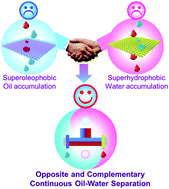Opposite and complementary: a superhydrophobic–superhydrophilic integrated system for high-flux, high-efficiency and continuous oil/water separation†
Abstract
A dual-membrane separation system was designed through integrating underwater superoleophobic and superhydrophobic membranes. Such an opposite and complementary combination achieved a highly adaptable, high-flux and continuous oil/water separation that is difficult to realize via the current single membrane methodology. This research provides a versatile strategy for designing separation devices and promotes practical applications in wastewater treatment and oil spill clean-up.


 Please wait while we load your content...
Please wait while we load your content...